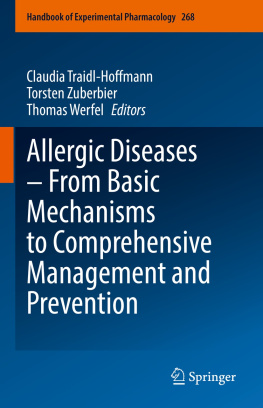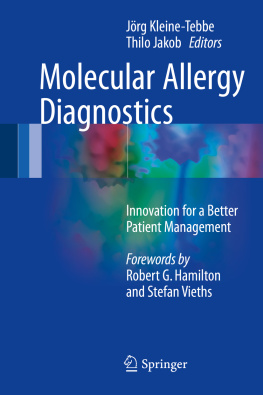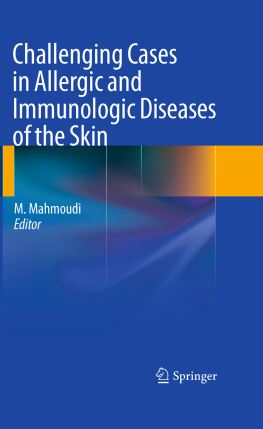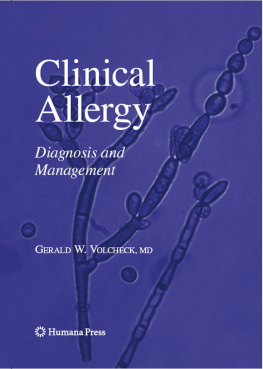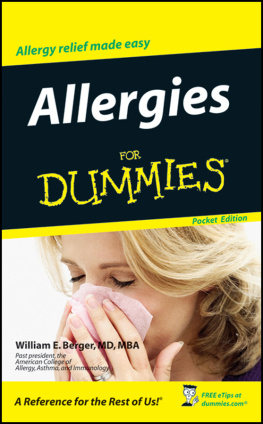Cover
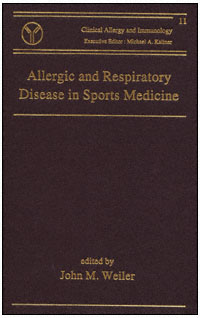
| title | : | Allergic and Respiratory Disease in Sports Medicine Clinical Allergy and Immunology ; 11 |
| author | : | Weiler, J. M. |
| publisher | : | Informa Healthcare |
| isbn10 | asin | : | 0824798902 |
| print isbn13 | : | 9780824798901 |
| ebook isbn13 | : | 9780585381916 |
| language | : | English |
| subject | Respiratory organs--Pathophysiology, Exercise--Physiological aspects, Asthma, Sports medicine, Asthma, Exercise-Induced, Respiratory Tract Diseases, Sports Medicine. |
| publication date | : | 1997 |
| lcc | : | RC732.A42 1997eb |
| ddc | : | 616.2 |
| subject | : | Respiratory organs--Pathophysiology, Exercise--Physiological aspects, Asthma, Sports medicine, Asthma, Exercise-Induced, Respiratory Tract Diseases, Sports Medicine. |
Page a
Allergic and Respiratory Disease in Sports Medicine
Page b
CLINICAL ALLERGY AND IMMUNOLOGY
Series Editor
MICHAEL A. KALINER, M.D.
Medical Director
Institute for Asthma and Allergy
Washington, D.C.
- Sinusitis: Pathophysiology and Treatment, edited by Howard M. Druce
- Eosinophils in Allergy and Inflammation, edited by Gerald J. Gleich and A. Barry Kay
- Molecular and Cellular Biology of the Allergic Response, edited by Arnold I. Levinson and Yvonne Paterson
- Neuropeptides in Respiratory Medicine, edited by Michael A. Kaliner, Peter J. Barnes, Gert H. H. Kunkel, and James N. Baraniuk
- Provocation Testing in Clinical Practice, edited by Sheldon L. Spector
- Mast Cell Proteases in Immunology and Biology, edited by George H. Caughey
- Histamine and H-Receptor Antagonists in Allergic Disease, edited by F. Estelle R. Simons
- Immunopharmacology of Allergic Diseases, edited by Robert G. Townley and Devendra K. Agrawal
- Indoor Air Pollution and Health, edited by Emil J. Bardana, Jr., and Anthony Montanaro
- Genetics of Allergy and Asthma: Methods for Investigative Studies, edited by Malcolm N. Blumenthal and Bengt Bjrkstn
- Allergic and Respiratory Disease in Sports Medicine, edited by John M. Weiler
ADDITIONAL VOLUMES IN PREPARATION
Page i
Allergic and Respiratory Disease in Sports Medicine
edited by
John M.Weiler
University of Iowa
Iowa City, Iowa

Page ii
Library of Congress Cataloging-in-Publication Data
Allergic and respiratory disease in sports medicine / edited by John
M. Weiler.
p. cm. (Clinical allergy and immunology; 11)
Includes index.
ISBN 0-8247-9890-2 (hardcover: alk. paper)
1. Respiratory organsPathophysiology. 2. Exercise
Physiological aspects. 3. Asthma. 4. Sports medicine.
I. Weiler, J. M. II. Series.
[DNLM: 1. Asthma, Exercise-Induced. 2. Respiratory Tract
Diseases. 3. Sports Medicine. W1 CL652 v.11 1997 / WF 553 A433
1997]
RC732.A42 1997
616.2dc21
DNLM/DLC
for Library of Congress
97-5181
CIP
Please note: Drugs and dosages presented in this text are intended to provide information but are not guaranteed to be accurate. Before prescribing any of the drugs suggested here, the prescriber should be familiar with the medication(s) and should check package label instructions.
The publisher offers discounts on this book when ordered in bulk quantities. For more information, write to Special Sales/Professional Marketing at the address below.
This book is printed on acid-free paper.
Copyright 1997 by MARCEL DEKKER, INC. All Rights Reserved.
Neither this book nor any part may be reproduced or transmitted in any form or by any means, electronic or mechanical, including photocopying, microfilming, and recording, or by any information storage and retrieval system, without permission in writing from the publisher.
MARCEL DEKKER, INC.
270 Madison Avenue, New York, New York 10016
http://www.dekker.com
Current printing (last digit):
10 9 8 7 6 5 4 3 2 1
PRINTED IN THE UNITED STATES OF AMERICA
Page iii
To
Kay, Rebecca, and Jamie
and to
the Comets
Page iv
This page intentionally left blank.
Page v
Preface
Studies and reports presented over the past two decades provide the basis for recognizing the importance of the disorders described in this text. The landmarks in sports medicine are well described in this book and include: 1) testing for drug doping beginning in the 1960s; 2) the 1972 disqualification of an American Olympic swimmer for using a banned substance, and the loss of his gold medal; 3) a report in 1976 by Bierman et al. suggesting that 90% of chronic asthmatic subjects and 40% of those with allergic rhinitis have exercise-induced asthma; and 4) the report that United States athletes who participated in the 1984 Summer Olympic Games in Los Angeles had an 11% prevalence of exercise-induced asthma. Sports medicine is now recognized as a subspecialty, and practitioners are able to take an examination that may lead to certification in sports medicine. Consequently, it is timely and appropriate to present now the first book dedicated entirely to allergic and respiratory disease in sports medicine.
This book is divided into logical sections. Chapters 1 and 2 present a background for the effects of exercise on the respiratory system and describe the mechanics of performing exercise challenges. Chapters 3 and 4 review the history and prevalence of exercise-induced asthma and indicate clearly that we now recognize this disorder in about one in five athletes. Chapters 57 propose mechanisms for exercise-induced asthma, focusing on the role of respiratory water loss and mediator release. If mediators play a dominant role in this disorder, then many of the newer anti-mediator agents might be expected to be efficacious in the treatment of asthma that occurs with exercise. Similarly, if a late phase occurs after exercise (Chapter 7), then its treatment might require medications designed to treat chronic asthma.
Page vi
Chapter 8 describes the treatment of exercise-induced asthma with -agonists and Chapter 9 addresses the myriad of other medications that have been examined for efficacy in this setting. A remarkably large number of medications, ranging from antihistamines to calcium channelblocking agents to inhaled heparin to steroids, have proven efficacious. Indeed, new anti-asthma medications are often examined in early clinical trials for efficacy in preventing exercise-induced asthma as proof that the drug may be useful in treating chronic asthma. Chapter 10 examines the role of a nonpharmacological interventionconditioning and trainingin patients with exercise-induced asthma.
Chapters 1113 are devoted to the upper airway. This section describes the effects of exercise on rhinitis, the recognition and treatment of sinusitis, and upper airway conditions masquerading as exercise-induced asthma.
Next page

